Dhamrai Upazila
| Dhamrai ধামরাই | |
|---|---|
| Upazila | |
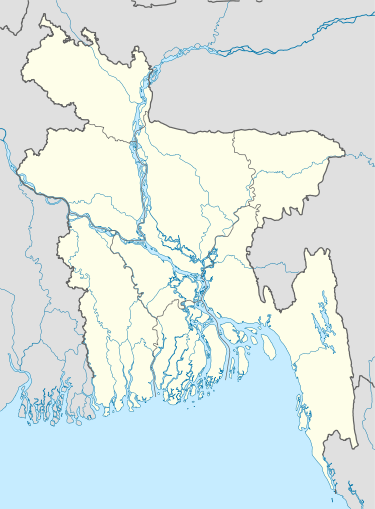 Dhamrai Location in Bangladesh | |
| Coordinates: 23°54.5′N 90°13′E / 23.9083°N 90.217°ECoordinates: 23°54.5′N 90°13′E / 23.9083°N 90.217°E | |
| Country |
|
| Division | Dhaka Division |
| District | Dhaka District |
| Area | |
| • Total | 307.4 km2 (118.7 sq mi) |
| Population (1991) | |
| • Total | 312,777 |
| • Density | 1,017/km2 (2,630/sq mi) |
| Time zone | BST (UTC+6) |
| Website | Dhamrai Upazila |
Dhamrai (Bengali: ধামরাই) is an Upazila of Dhaka District in the Division of Dhaka, Bangladesh.
Geography
Dhamrai Upazila is located about 40 kilometers north west of the capital city of Dhaka. It is one of the six Upazilas of Dhaka district. The Upazila is surrounded by the Upazilas of Mirzapur and Kaliakair and Nagarpur on the north, Singair on the south, Savar in the east and Saturia on the west.[1]
Dhamrai is located within the coordinates of 90.02 - 90.14E and 23.50 - 24.02E.
The total area of Dhamrai Upazila is 307.4 km².[1] It has 57,297 units of households. The Upazila consists of one ‘Pouroshova’ (Municipality), 16 unions and 398 villages.[1]
Dhamrai Upazila is composed of the alluvium soil of the Bongshi and Dholesshori rivers. Other rivers are Kolmai and Gazikhali.

Demographics
At the 1991 Bangladesh census, Dhamrai had a population of 312,777.[2] Males constituted 50.37% of the population, and females constituted 49.63%. The population of citizens 18 years and older was 163,449. Dhamrai had an average literacy rate of 29.5% (7+ years), lower than the national average of 32.4%.[2] The breakdown of Population is as follows:
- Total Population: 312,777;
- Male: 157,546;
- Female: 155,231;
- Density: 1,146/km2;
- Population Growth Rate: 1.59;
- Birth Rate: 2.0
Administrative
Dhamrai has 16 Unions/Wards, 281 Mauzas/Mahallas/Mouzas, and 398 villages.[1]
Dhamrai was once under the Thana (now Upazila) of Savar. Dhamrai became a Thana itself in 1914 during the British rule; the same year Dhamrai Hardinge High School was established. In 1947 it was put under the district of Dhaka. On December 15, 1984 Dhamrai was upgraded into a full-fledged Upazila.
Naming of Dhamrai:
There are two versions of how the name of Dhamrai came about:-
The first one is that during the time of Asoka the Great there was a Buddhist ‘Dharmarajika’ and the name became truncated and in time came to be known as Dhamrai. The discovery of a prehistoric Buddhist ‘stupa’ in Savar, about 10 miles away from Dhamrai lends credence to this opinion.
The other version, is that a famous Sufi Saint Hazrat Shahjalal came to, what is now Bangladesh, about eight hundred years ago with 360 companions. Legend has it that five of them (Tirmizi Al-Hussaini, Hazrat Hazi, Hazrat Gazi, Hazrat Zambahadur and Hazrat Shah Magdum)[3] came to Dhamrai area which was then sparsely populated and heavily forested. They settled and started leading a secluded life. Food supplies ultimately ran short and one day they found a stray cow wandering about. They slaughtered the cattle and used the meat to satisfy their hunger. After a few days a couple by the name of Dhama Gope and his wife Rai Goalini came and claimed that the cow was theirs. They demanded compensation for the cow. The Sufis learnt that the couple was childless. It is said that with their blessings a child was born to the couple and also they said that they would name the place so that their names would forever be remembered. Thus the name Dhamrai (Dham+Rai) came about.
Agriculture
The total cultivable land is 23,470 hectors.[3] Of the total cultivable land (in hectors):

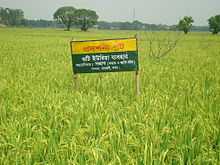
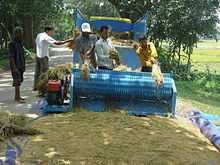
- 1 crop: 2,050
- 2 crop: 14,580
- 3 crop: 6,740
- More than 3 crops: 100
- Intensity of Cultivation: 220.83%
Farmers by Land Occupancy:
- Landless (less than 0.02 hectors): 11,755
- Marginal (0.02 - 0.20 hectors): 10,670
- Middle (1.01 - 3.0 hectors): 5,675
- Big (more than 3.0 hectors): 535
Food Production:
- Total demand (metric tons): 65,209
- Actual production (metric tons): 75,023
- Total Surplus (metric tons): 9,814
Education
There are 139 Government Primary schools; 15 High Schools; 25 Junior High Schools; 109 schools run by NGOs; 11 Madrasahs, 6 Colleges and 1 Agriculture College in Dhamrai Upazila.
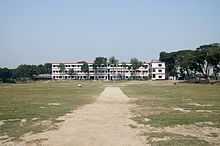
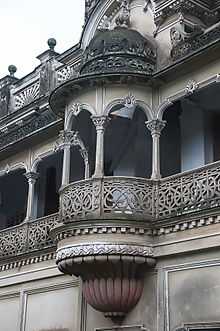
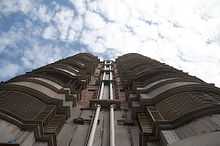
List of high schools in Dhamrai
- Haralal High School, Amta Established in 1887
- Ruail High School: Established in 1857, is one of the oldest schools not only in Dhamrai but of India and Bangladesh. It is one of the four schools established in British India as early as 1857, the year of the Sepoy Mutiny;
- Dhamrai Hardinge High School: Established in 1914 after the British Viceroy Lord Hardinge;
- Jolshing Elokeshi High School: Established in 1924;
- Jadavpur B M High School: Established in 1929;
- Berosh Shibnath Shastri Institution: Established in 1936;
- Suapur Nannar High School: Established in 1939;
- Kushura Abbas Ali High School: Established in 1941;
- Bhalum A.R. Khan High School: Established in 1957;
- Balia Wadudur Rahman High School: Established in 1957;
- Beliswar Mohini Mohon High School: Established in 1967;
- Nikla Z. Haque High School: Established in 1970;
- Bannol Lakkhu Haji High School: Established in 1969;
- Jalsha High School: Established in 1972;
- Shailan Surma High School: Established in 1973;
- Afazuddin High School: Established in 1988
- Bannol old scheme jounior Madrasha : Established in 1937.
List of Colleges in Dhamrai
- Dhamrai Govt. University College: is the highest educational institute of the locality.
- Nobojug University College: Established in 1972 in Kushura;
- Abul Bashair Krishi College: Established in 2003 in Mongolbari, Dhamrai;
- Ataur Rahman School & College: Established in 1987, Bhalum, Kalampur;
- Afaz Uddin School & College: Established in 1988 in Sharifbag, Dhamrai.
Notable former residents
Iswar Chandra Sen: He was born in Suapur village of Dhamrai in 1825. Father of the illustrious Dinesh Chandra Sen, he was also a friend of the poets Krishna Chandra Majumdar and Harish Chandra. He published Brahma Sangeet Collection and later a book on the history of Dinajpur. Many of his articles were published in the then “Englishman” newspaper. The famous proponent of Brahma Dharma Pandit Shibnath Shastri was one of his admirers. Iswar Chandra died in 1886.
'eldest sonDinesh Chandra Sen': Son of Decemb Chandra Sen, he was a famous historian. His book “Bengali Language and Literature" is regarded as the first complete work on the subject. Another noteworthy work of his was the collection and editing of “Moymonshingho Geetika”. He wrote 55 books in Bangla and 12 in English. He was awarded D. Lit in Literature and such titles as Ray Bahadur. He was the Reader in Calcutta University, member of the Senate and the first Head of the Department of Bengali. He died in 1939.
Kedarnath Roy: Born in Suapur village of Dhamrai in 1860, was the husband of the illustrious poet Kamini Roy. He was a “Statutory Civilian” during the British Rule. He died in 1909.
Kamini Roy: She was born in 1864 in Bakerganj (now Barisal) and was married to Kedarnath Roy of Suapur, Dhamrai. An illustrious poet and the first female honors graduate, Kamini Roy was also a Professor at Bethun and the Vice President of Bongiyo Shahitto Porishod. She wrote many books on literature and was the recipient of a Gold Medal from Calcutta University for her outstanding works. She died in 1933.
Onukul Shorkar: He was born in Suapur village and became a “Prem-Chaad Roy-Chaad” scholar and Ph.D holder in Chemistry. He served as a Professor at the Dhaka College and Calcutta University.
Ataur Rahman Khan: He had a long and chequered career. Born in Balia village in December 1907, Ataur Rahman Khan passed the entrance examination to Pogose School of Dhaka in 1924 and B.A. Honors in Economics from Dhaka University in 1936. Ataur Rahman Khan served as a Minister in 1964 and in 1956 became the Chief Minister of the then East Pakistan and continued office till the declaration of Martial Law. In 1984 he joined General Ershad’s government and was made the Prime Minister and continued until January 1985. He wrote three books of which Ojarotir Dui Bochor was notable.
Two of his brothers also gained prominence. Shamsur Rahman Khan was appointed as the first Bangladesh Ambassador to USSR. Wadudur Rahman Khan was a Professor of History at Dhaka University.
--(Mowlana Tomizuddin Ahmed & A.K Afazuddin Ahmed)-- Mowlana Tomiz uddin Ahmed He was born in bannol. He achieved his first education in his family, then he went to India for higher degree from university of dar-ul-ulum dew bond.He & his eldest son A. K. Afazuddin Ahmed were most power full spiritual teacher in Bangladesh. A.K Afazuddin ahmed was the founder one of the oldest school of Dhamrai is bannol govt. primary school, on the other hand Mowlama tomizuddin Ahmed was the friend of Mawlana vasani. He was judge of jurisprudence in Dhaka court. He go away from world in 1976 & his eldest son A.k Afazuddin Ahmed was died in 14 December 1991.
Culture
DHAMRAI ROTH JATRA AND FAIR:

The annual Jagannath Roth Jatra is a famous Hindu festival attracting thousands of people. Dhamrai is well known for this annual festival all throughout Bangladesh. Roth jatra festival begins on around the 10 day of Bangla Calendar month of Ashar and "Ulto Roth" takes place one week after. A month-long Roth Maela (রথ মেলা) is held in Dhamrai for this occasion. This commemorates the annual journey of Lord Jagannath, Lord Balarama, and their sister Subhadra to their aunt's temple. During the festival, devotees help pull the Lords' chariot with ropes. They consider this a pious deed and risk their lives in the huge crowd. The huge processions accompanying the chariots play devotional songs with drums, tambourines, trumpets etc. Children line the streets through which the chariot will pass and add to the mass chorus. The Roth cart is approximately 45 feet (14 m) high and pulled by the pilgrims who turn up for the event.
METAL CASTING:
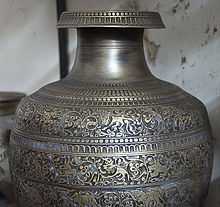
The main center for metal casting in Bangladesh is in Dhamrai. For many generations, this place has produced handmade metal ware for markets throughout Bangladesh, using the lost wax casting (cire perdue) method that is over 2,000 years old. These methods are used to make items ranging from ornate Hindu and Buddhist statues to simple household objects such as pitchers (kolshi as is locally called) and also items include quality statues, decanters, bowls, spoons and plates. Over the past fifty years, many of the families in Bangladesh who have been involved in the metal casting trade have taken on other work. With stiff competition from inexpensive machine-made aluminum and plastic products coming in from India and other countries in the region, the market for handcast items has gradually dwindled away. As a result, the tradition of making handmade cast metal objects is in jeopardy. For example, there are only six people left in Bangladesh who are capable of making masterpiece-quality Hindu and Buddhist images using the lost wax method. Twenty years ago, there were over 30 craftsmen who knew this technique. If this trade is someday lost, an important part of Bangladesh's artistic tradition will vanish forever. Dhamrai is also well known for pottery.
NGOs working in Dhamrai:
- SOJAG: Works throughout Dhamrai and adjoining Upazilas of Mirzapur, Shaturia, Kaliakoir and Singair. The headquarters is at village Shailan under Shombhag Union.
- Grameen Choa: Located at Dhantara Bazar, Dhamrai
- SDI: Located at Dhamrai Bazar, Dhamrai
Tourist attractions
Mosques:
- Chapil
- Shailan,
- Depashai,
- Moqamtola Mazar,
- Paach Peer Mazar and Mosque,
- Buchai Pagla Mazar in Batulia
Hindu Temples:
- Gopnagar Gour Nitai Mondir, Dhamrai.
- Dhamrai Madhob Mondir,
- Toperbari Kali Mandir, Kusura
- Gomegram Kali Mondir,
- Khagail Vokto Mondir,
- Mogirar Chor Krishno Mandir,
- Gairakul Giridhari Mondir,
- Boinna Kali Mondir,
- Dhamrai Roth
- Picnic Spot: Chapil Udioman Nabin Shanga Picnic spot, Mohammadi Garden in Mohishashi near Kushura
- Historical Place: Belishshor Babu Bari
Animals & Birds
Dhamrai is a natural habitat for monkeys. A substantial number of monkeys have Dhamrai township and adjoining areas as their natural habitat. Besides, there are quite a few water bodies (beels/lakes) where migratory birds come during winter months.
Political and Administrative
M A Malek, MP (Member of Parliament(Awami League)
- Mr. Alhaj Tamiz Uddin: Upazila chairman.
- Mr. Dewan Nazimuddin Monju: Mayor of Dhamrai Pouroshova
- Mr. mohaddes hossain: upazila vice chairman.
- Mrs.sohana jesmin mukta: upazila vice chairman(women).
Gallery
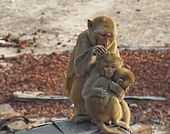 Dhamrai Monkey Family |
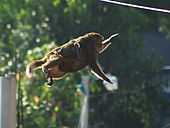 Monkey Leap |
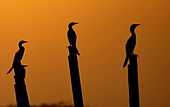 Dhamrai Cormorants |
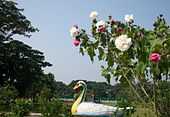 Mohammadi Garden at Mohishashi |
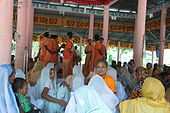 Vokto Mela |
 Dhamrai Police Station |
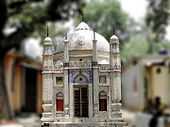 Moqamtola Mazar |
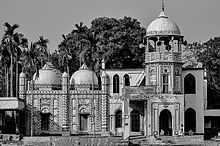 85-yr old mosque at Shailan |
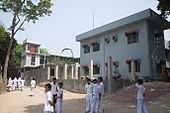 SOJAG Office at Shailan |
 Silver necklaces by Dhamrai Artisan |
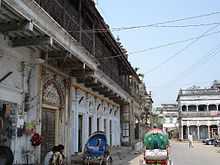 Old Buildings in Dhamrai |
 Majestic old building in Dhamrai |
 Old Dhamrai Roth burnt by Pakistani Army in 1971 |
Dhamrai Boishakhi Mela Pano |
 Shailan-school-mosque-panorama |
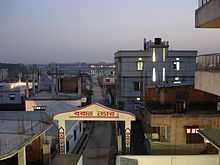 Borat Nogor at dusk |
_at_night.jpg) ACME across Dhamrai Beel |
 Paach Peer Mazar at Pathantola |
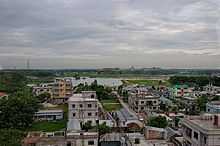 South end of Dhamrai Township |
 Potter at work in Dhamrai |
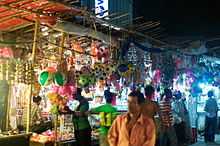 Stalls in Dhamrai Roth Fair |
 Durga Puja in Dhamrai |
 Madhob Mondir, Jatrabari, Dhamrai |
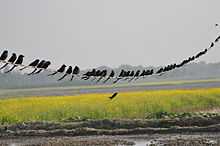 Drongas line up for insects |
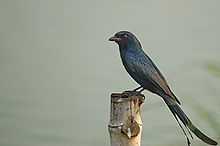 Lone Drongo in Dhamrai |
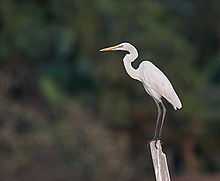 Great White Egret in Dhamrai Beel |
 Dhamrai Chemeleon |
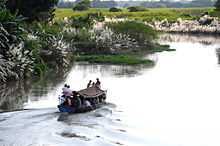 Boat on River Bongshi |
See also
References
| Wikimedia Commons has media related to Dhamrai Upazila. |
- ↑ 1.0 1.1 1.2 1.3 Md Ilias Uddin (2012). "Dhamrai Upazila". In Sirajul Islam and Ahmed A. Jamal. Banglapedia: National Encyclopedia of Bangladesh (Second ed.). Asiatic Society of Bangladesh.
- ↑ 2.0 2.1 "Population Census Wing, BBS.". Archived from the original on 2005-03-27. Retrieved November 10, 2006.
- ↑ 3.0 3.1 Booklet published by Dhamrai Upazila Krishibid Association; published June 2012; Edited by Dulal Chandra Sarkar and Mohammad Shahadat Hossain
